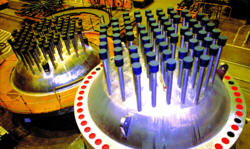Showing that it works could renew efforts by countries to develop the process
General Electric says it has successfully tested a faster, cheaper way to produce nuclear reactor fuel, and is planning to commercialize the technology by building a facility in Wilmington, N.C. While the prospect of saving resources to generate energy at a lower price sounds like a breakthrough, scientists are concerned that the top-secret method of enrichment that GE is using will indirectly elevate proliferation risks around the world, thus inspiring rogue states to develop their own laser enrichment facilities for nuclear weapons.
The enrichment technology is the Separation of Isotopes by Laser Excitation (Silex). It was developed by Silex of Australia in 1992. The technology company USEC funded early research on Silex, but abandoned it in favor of focusing on centrifuge enrichment. In 2006, GE signed an exclusive agreement to commercialize and license the technology and spearhead further research and development.
Although Silex is the only known method of laser enrichment that works and could be commercially viable, scientists are concerned because many countries have funded laser-enrichment projects. According to the U.S. Council on Foreign Relations, more than 20 countries have researched laser isotope separation techniques, including China, India, Iraq, Russia, Japan and Pakistan. Although they were unsuccessful, scientists say that putting Silex back into the public eye, regardless of the safeguards GE promises, poses a problem. Showing that it works could renew efforts by countries to develop the process.
“Once you popularize the technology, you draw attention to it and have people out there that have bits and pieces, and may talk to other people,” says a scientist knowledgeable about Silex, who asked to remain anonymous. “Anyone who has tried it, plus anyone who thinks this is a promising way forward” may try to use Silex if they see that it works.
“The people who were not able to do it in the past because they were using older styles of laser enrichment will say ‘this is what we’re doing wrong,’” the scientist adds. “In every country, there is a bureaucracy or interest section that may find this as an obvious and natural research agenda for them.”
GE has a different view. “There are considerable barriers that make the chances of development of the technology by potential proliferators highly unlikely,” says Christopher Monetta, president and CEO of GE-Hitachi Global Laser Enrichment, in an email. “The process is technically complex and depends on the combination of . . . experts, complex technologies and significant investment. The advantage of laser enrichment is economical, not ease of development or deployment.”
In 2007, GE and Hitachi formed an alliance to develop nuclear energy, with one intention being the testing of Silex for commercial use. That company is GE-Hitachi Nuclear Energy. In the same year, its subsidiary GE-Hitachi Global Laser Enrichment (GLE) received approval from the U.S. Nuclear Regulatory Commission (NRC) for R&D to test the method at its headquarters in Wilmington. In 2009, the company submitted a license request for a 600,000-sq.-ft. commercial uranium enrichment facility on a 100-acre site near to where GE operates a nuclear fuel manufacturing center and makes fuel assemblies.
If GE determines that Silex is economically feasible to produce on a large scale, the facility would enrich natural UF6 gas into the uranium-235 (U-235) isotope with lasers. Naturally occurring uranium ore contains 0.75% of the U-235 isotope. That concentration needs to be increased to 3-5 weight percent to transform the uranium into reactor fuel. The target capacity could be 6 million work units per year, enough to power 42 reactors annually.
GLE’s material will be far less rich in U-235 than any kind of bomb material. Generally, nuclear weapons contain weight percent greater than 80-90%. So, security concerns about what happens to the material that is created at GLE’s site are irrelevant. Instead, the debate is that if GLE proves that this once-dormant and powerful technology works, other countries may be inspired to try again.
One big concern about Silex is that it requires significantly less electricity, resources and facility space than gas centrifuge enrichment. Also, while governments are familiar with means for detecting gas centrifuge plants, the same methods do not exist for laser enrichment because it is so new.
Read more . . .
Bookmark this page for “uranium enrichment” and check back regularly as these articles update on a very frequent basis. The view is set to “news”. Try clicking on “video” and “2” for more articles.








